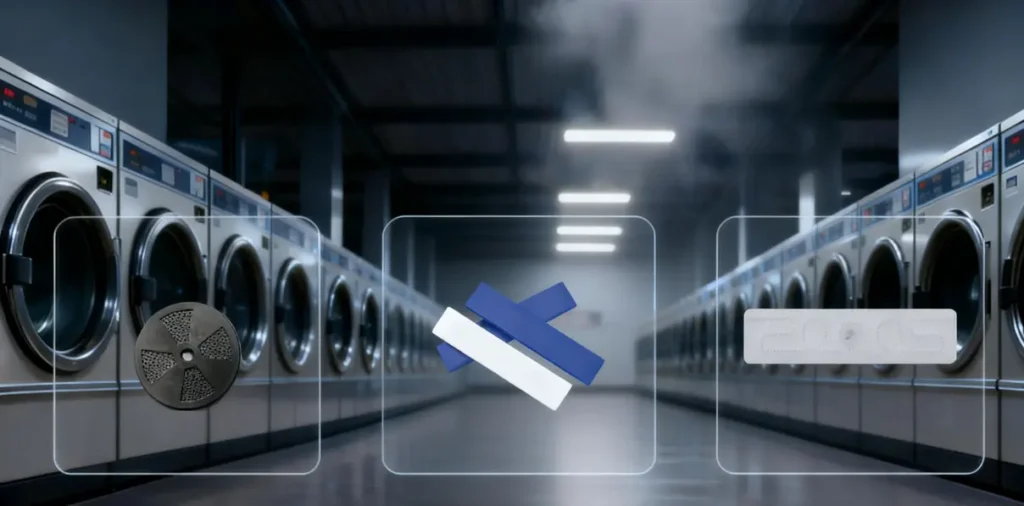
RFID Laundry Tags: PPS vs Textile vs Silicone
Custom Your RFID Cards
Choosing the right material for RFID laundry tags is essential. In our experience working on RFID laundry projects, we consistently notice that the key concern is can the tags withstand repeated washing and reading cycles while fitting smoothly into existing operations.
Industrial laundry expose tags to high heat, strong chemicals, and mechanical stress. The wrong choice can lead to tag failure, disrupted operations, and higher replacement costs. Here we will compare the 3 main RFID laundry tag materials — PPS, Silicone, and Textile across performance, form & installation, and cost-effectiveness to help you choose the right fit for your application.
Material Performance: Durability & Reliability
Heat Resistance: — Who Survives at 200°C?
PPS – High-Temperature Champion
PPS can withstand temperatures above 200 °C, making it ideal for processes like industrial ironing, tunnel finishing, and autoclave sterilization. Its rigid structure keeps the chip protected even under intense heat and mechanical pressure.
Silicone – Flexible but Heat-Tough
Silicone tags also tolerate temperatures up to around 200 °C and absorb mechanical stress thanks to their elasticity. They work well in applications that require both high-temperature sterilization and user comfort.
Textile – Moderate Heat Tolerance
Textile or fabric tags typically handle 120–160 °C. Performance depends heavily on the quality of the chip’s sealing and the stitching method. They’re best suited for lower‑temperature commercial laundry environments.
Our Take: In projects where heat resistance was underestimated, early tag replacement became unavoidable. PPS consistently outperforms silicone and textile in extreme heat conditions.
Chemical Resistance
Industrial laundries rely on strong cleaning agents, including chlorine-based bleach and alkaline detergents.
- PPS: Highly resistant to chemical attack, maintaining integrity after hundreds of wash cycles.
- Silicone: Good resistance to detergents and mild acids; prolonged exposure to oxidizers may cause surface fading.
- Textile: Performs well with neutral detergents but degrades faster under concentrated or caustic solutions.
Our Take: In hospital or high‑bleach laundry applications, PPS tags dramatically reduce replacement frequency compared with silicone or textile variants.
Mechanical Strength & Impact Resistance
- PPS: Rigid structure that protects the embedded chip from compression, spinning, and centrifugal forces.
- Silicone: Soft yet resilient, absorbs impact and returns to shape after bending.
- Textile: Highly flexible and comfortable but provides limited protection for the chip.
Our Take: Ignoring mechanical stress often leads to chip failure even when heat and chemical resistance are sufficient. PPS is best for high‑impact industrial processes; silicone balances durability and flexibility; textile suits low‑stress, comfort‑oriented applications.
Form, Installation & User Experience
Material performance is only part of the equation — how a tag is attached also affects reliability, maintenance, and user comfort.
Tag Form & Flexibility: Hard vs. Soft Materials
- PPS Laundry Tags: Two‑hole tags are stitched, solid tags sealed in pockets or pouches, and single‑hole types used for specific hanging systems.
- Silicone Laundry Tags: Available in strip or capsule shapes for heat‑sealing or seam insertion.
- Textile Laundry Tags: made for direct sewing or heat‑sealing into garments. They blend seamlessly with clothing labels.
Installation Comparison
| Material | Typical Form | Installation Method | Notes |
|---|---|---|---|
| PPS | Rigid round disc (with or without holes) | Sew with heat-resistant thread, or insert into fabric pocket | Requires defined position for stable reading |
| Silicone | Flexible strip or capsule | Heat-seal or sew into garment seam | Soft and washable, suitable for wearable textiles |
| Textile | Fabric label form | Sew or iron directly | Easiest to integrate, minimal user discomfort |
Our Take: Installation is as critical as material. Incorrect mounting leads to failures even with the best tags. Sample testing is essential before full deployment.
Cost Efficiency & Recommended Applications
Quick Comparison Table
| Feature | PPS | Silicone | Textile |
|---|---|---|---|
| Form | Hard disc | Soft strip/capsule | Fabric label |
| Heat Resistance | Very high (200°C+) | High (up to 200°C) | Medium (120–150°C) |
| Chemical Resistance | Excellent | Very good | Moderate |
| Flexibility/Comfort | Low | High | Highest |
| Installation Difficulty | Medium | Easy | Easy |
| Lifecycle Cost | Lowest | Higher | Medium |
| Recommended Use | Hospital linens, uniforms | Protective clothing, medical garments | Rental garments, low-stress textiles |
Best Material by Application
✅ Choose PPS
When your laundry process involves high temperature, high pressure, and strong chemicals, such as in hospital linens, industrial uniforms, or hotel textiles.
✅ Choose Silicone
When comfort and flexibility are essential — for medical staff clothing, patient garments, or washable accessories.
✅ Choose Textile
When you need low-cost, lightweight integration in rental, fashion, or low-temperature laundries.
Conclusion: Material Choice Must Match Laundry Environment
Selecting the right RFID laundry tag is not about finding the “best” material, but matching material properties, installation method, and washing conditions.
We’ve found that early alignment between environment, workflow, and tag design dramatically reduces failures and replacement costs. PPS excels under extreme conditions, Silicone balances durability and comfort, and Textile offers lightweight flexibility.
Proper testing of read performance, attachment stability, and chemical resistance before deployment ensures long-term success in any industrial laundry setting.
Ready to Find Your Perfect Match?
Explore our full range of RFID laundry tags by material:
👉 PPS RFID Laundry Tags
👉 Silicone RFID Laundry Tags
👉 Textile RFID Laundry Tags
Still not sure? Contact us for expert guidance on selecting the best RFID laundry tags for your specific environment.


